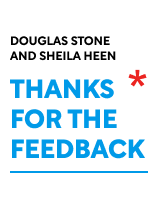

This article is an excerpt from the Shortform book guide to "Thanks for the Feedback" by Douglas Stone and Sheila Heen. Shortform has the world's best summaries and analyses of books you should be reading.
Like this article? Sign up for a free trial here .
How do you react to feedback? What factors determine whether you are going to act on the feedback given or dismiss it as unimportant?
According to communication experts Douglas Stone and Sheila Heen, we react to feedback, not because of the content of the feedback itself, but because of who gave it to us and our relationship with them. If we receive feedback from those we like (relationship trigger 1) and who treat us well (relationship trigger 2), we are more likely to heed their insights. Otherwise, we look for ways to disqualify the feedback.
In this article, we’ll discuss the psychology of feedback in terms of two relationship triggers, which have to do more with the person giving the feedback than the feedback itself.
Douglas Stone & Sheila Heen: The Psychology of Feedback
Understanding the psychology of feedback can help you respond to it more effectively. According to Douglas Stone and Sheila Heen, there are two reasons why you react to feedback the way you do: 1) your opinion of the feedback giver, and 3) the way you treat them. They call them “relationship triggers.”
The way to manage relationship triggers is to disentangle the feedback from the person giving it and examine each separately. Relationship triggers are typically caused by one of two dynamics: how we feel about the other person, and how we are treated by them.
Relationship Trigger #1: Our Opinion of Them
If we receive feedback from a person we admire greatly, we tend to accept it without reservation. When receiving feedback from most people, though, we are quick to look for something that disqualifies them from giving it. These are commonly:
- The giver’s skill or judgment (did they give the feedback in the right place, or in the right format?)
- Her credibility (does she even know what she’s talking about?)
- Her trustworthiness
Skill or Judgment: Do They Give the Feedback Properly?
If a person gives feedback in an inappropriate way, at an inappropriate time, or in an inappropriate place (the how, the when, and the where), it shows a lack of skill and judgment, and you are likely to ignore the feedback because of it. (“How dare she bring this up in front of a client?”; “She waited until after we presented to raise this?”)
While your reaction may be justified, it leaves the original feedback unaddressed. When you find yourself reacting to the “how, when, or where” of a person’s feedback, keep in mind that the “what” is separate, and may be worth exploring regardless of the method of delivery.
Credibility: How Would They Know?
We are similarly likely to ignore feedback from someone if she lacks experience or expertise in the area in question, or if she doesn’t share our values. (“She’s never lived abroad, how would she know?”; “She’s an aggressive manager, I don’t want to take her advice.”)
When we dismiss this feedback, though, we risk missing out on important new perspectives. Outsiders and newcomers can offer insights that people close to a situation miss because they are used to doing things in a certain way. In business, new and revolutionary ideas often come from people who are free to think outside the box because they don’t know where the boundaries of that box are. Even “naive” questions can be revealing, pointing out something the “experts” missed because they’re too well-acquainted with a project. Outsiders can also see interpersonal dynamics that might have become invisible to two people directly involved in a relationship.
This is not to say that credibility and experience are unimportant; they should always be considered as you put feedback into context. But don’t use lack of credibility as a reason to automatically reject it.
Trust: What Are Their Real Motives?
We mistrust people when we question their intentions, and when we feel:
- They want to hurt us.
- They have their interests in mind, not ours.
- They don’t actually care—they’re giving feedback as an obligation, but it’s not sincere or thoughtful.
The problem is, we can’t ever really know a person’s intentions. If we try too hard to determine them, we might end up assuming motivations that don’t really exist.
Furthermore, intentions are irrelevant to the feedback itself. Maybe she does intend to hurt you by telling you your project is unfocused. But she may be right. Conversely, your friend might have your best interests in mind when she tells you to wear flip flops to that wedding. But that may not be an appropriate wardrobe choice.
Even if you don’t feel you can trust the person giving you feedback, treat the question of her intentions as separate from the content of her feedback. Examine her feedback on its own merits, and don’t let your suspicion of her intentions cloud the advice itself.
Relationship Trigger #2: Their Treatment of Us
Our perception of how the other person treats us often determines whether or not we accept or ignore her feedback. There are three relationship elements that often affect us:
- Appreciation
- Autonomy
- Acceptance
Appreciation
If we feel we’ve gone to great efforts in some way, and those efforts are not acknowledged, we often react emotionally to that snub rather than listen to the other person’s feedback. It’s a perception of imbalance: even if her comments are accurate, we feel they’re inappropriate given your efforts.
Say you’ve been picking up your colleague’s responsibilities on a project because she’s swamped with an unexpected setback on a different project. If she comes to you and asks why you sent her client these materials instead of those, you may get triggered. Instead of thinking, “Thank you, I see now how those materials are more relevant,” you might think, “Do you not see all the effort I’m putting in for you?”
Autonomy
We have an innate sense of who is allowed to tell us what to do in different situations. When we feel someone is telling us what to do but does not have the authority to do so, we get triggered. We feel indignant that the other person misunderstands her role. If your manager asks to review your weekly updates to your sales team before you send them out, you may react with resentment: “It’s not her place to micromanage my emails.”
Our emotional reaction to this trigger might cause us to reject the advice itself. We might find ourselves dismissing her advice on messaging because we’ve decided she doesn’t have the right to advise us on it.
It’s important to, once again, separate the content of the feedback from the trigger. Then, raise the issue with the other person. An open conversation might reveal that her views of her authority over you in this matter are situational, temporary, and justified. For example, if you explain that running all of your communications by her will add unreasonable time constraints to your projects, she might explain that since you’ve only recently taken on the weekly updates, she wants to be sure your messages align with the company’s standards.
Acceptance
The relationship trigger of acceptance comes from the contradiction inherent in feedback: We find it hard to take feedback—advice on change—from a person who doesn’t accept us as we are now.
This dynamic is sometimes triggered when the two people in the conversation have a different understanding of each person’s standards for acceptance. While the giver may intend a piece of feedback to mean a small change, the receiver may interpret it as a rejection of her entire person. For example, your colleague may advise you to dress better if you wish to get noticed. She may see this as a small change you can do that will pay big dividends. You, however, may see it as an affront on your person: You plan to advance based on merit, not superficial standards.
Sometimes our reaction to an acceptance trigger reveals a desire to resist change entirely. When we feel ourselves reacting to feedback by saying things like, “That’s just who I am!” or “That’s just me being me,” we need to ask ourselves if what we are truly after is an excuse to not change, or rather, to make other people change their expectations to accommodate our actions.
Switchtracking: A Common Response to Relationship Triggers
Often when we are relationship-triggered, we “switchtrack”: We respond to a piece of feedback with a reciprocal piece of feedback that is usually aimed at the person raising the issue rather than the issue itself. It changes the subject from the feedback itself to the relationship; from the “what” to the “who.” For example, if your roommate tells you she’s tired of you not cleaning up the kitchen, and you respond, “Why are you always so critical of me?”, you’ve just switchtracked the conversation.
In switchtracking, a conversation splits and starts following two entirely different tracks. Problems then arise when we don’t realize we are dealing with two separate topics, resulting in two people talking over one another. When Charlie brings home caramels for Sue, he expects a warm “thank you.” Sue, however, reminds him that she’s mentioned several times that she doesn’t like caramels. Charlie accuses Sue of never appreciating his affectionate efforts. Sue accuses Charlie of not listening to her. They are no longer talking about caramels but may not realize the two new topics on the table: her appreciation and his attention.
Controlling Relationship Triggers
Control your relationship triggers by properly managing switchtracking and then stepping back to see the whole system.
Manage Switchtracking
Manage switchtracking by acknowledging the two topics and giving each its own conversation track.
Acknowledge the Two Topics
You can’t disentangle two topics from each other until you are first aware of each. Spotting switchtracking takes practice. Be alert for conversations where one person raises an issue and the second person responds with a statement or question that focuses on the other person herself, instead of the content of the issue. That’s a clue that switchtracking is taking place.
For example, a manager approaches her salesperson about her lagging sales numbers this month, and the salesperson responds, “You’re bringing this up at 4:00 on a Friday?” Topic one is the performance of the salesperson. Topic two is the judgment of the manager in bringing it up at the wrong time.
Discuss the Two Topics
Once you’ve identified switchtracking happening, you can break the dynamic so you end up with a productive give-and-take discussion.
Give each topic its own track: As soon as you realize that you and the other person are talking about two different things, say so. Acknowledge the two topics: “I see two related but separate topics that we need to discuss.”
Acknowledge that they’re both important: “We need to talk about both.”
Outline a way forward: “Let’s address the first topic fully and then, separately, we’ll discuss the second.” Being hyper explicit like this is not how people normally talk, but that’s what makes it so effective: It breaks the flow of the conversation, and interrupts the chain of reactions that can derail it.
All things being equal, you should discuss the topic that was first raised. You wouldn’t be having the conversation if not for the first person’s original suggestion, so it makes sense to start there.
However, if the relationship trigger is so strong that it hampers your ability to address the original issue, say so and suggest that that topic gets discussed first. Clearing the air of the emotional trigger will allow you both to ultimately better address the original issue, which is what the other person wants as well. For example, if a husband reacts with anger when his wife brings up a problem with their taxes, she may need to discuss his reaction before she feels comfortable talking about the accounting error.
Watch for additional triggers as you discuss: Even after you’ve distinguished between two separate topics, you can still misunderstand exactly what those topics are. Look for meaning behind the words that indicate relationship-focused concerns. If the other person tells you, “Work is stressing you out,” and you respond, “Not at all; if I’m not keeping busy, I get restless,” you may feel that you’ve addressed her concern. But if her real point was, “I miss you because you work too many hours,” then you’ve missed the real problem.
Understanding Systems
Finally, to fully understand all the dynamics that can influence a relationship, you must understand your relationship as a part of a larger system. Often, conflicts are a result of the system not working properly more so than because of the specific characteristics of the two people involved in the dispute. Look at the system to get a truly clear picture.
A “system” is a set of parts that operates as a complex whole. Each part influences the others. A team, a company, and a relationship are all examples of systems.
When something goes wrong in a system, each player will see a small piece of the system that caused the issue. Typically, each regards the other person, not themselves, as the source of the problem. Your manager might see that you missed the deadline, while you might see that she gives unrealistic deadlines.
To properly understand the system and how it’s affecting the performance of everyone operating within it, you need to step back and look at it as a whole, rather than from your own specific vantage point that only allows you to see certain aspects.
One Step: Discover Intersections
Although feedback is usually presented as “This is how you are causing a problem,” the real issue is typically “This is how our differences are clashing.” These clashes are “intersections” where differences in opinion, values, and habits cause friction and feed a larger system of conflict. Your need to sleep in on the weekends is only a problem in relation to how it affects his plans to spend time with you and the kids.
The real problems begin when each of these individual conflicts starts creating additional conflicts, becoming a system of cause and effect that feeds on itself. When he insists you rise early on Saturdays to spend a full day with the family, you feel cheated of some much-needed down-time. He, though, misses you during the week because you’re working so much. When you start making excuses to find alone time on the weekends, he feels even more neglected and tries harder to capture your attention, which pushes you further away, and on and on.
From inside the system, we can only see the pieces we are immediately responding to. Taking “one step back” means looking at the pieces that the other person is responding to. Only then can you begin to spot patterns and intersections you were previously blind to.
Two Steps: Examine Roles and Adversity
Taking a second step back allows you to look not just at the way your habits intersect with the other person, but also reveals the roles you each play in the relationship.
Roles exist only in relationship to other roles. You are not a wife until you have a husband. You are not a mentor until you have a mentee.
Roles have an effect on behavior. If she is the cop and you are the driver who just ran a red light, your interaction is likely to play out in a fairly predictable way.
Roles can create adversity between two people who otherwise would not conflict. Harried teachers and demanding parents, human resources reps and disgruntled employees, and ex-husbands and the new boyfriend are all examples of people who have been put into roles that encourage adversity towards other people not because of their particular personalities, but because of the parts they play in the system.
Three Steps: Look for the Big Picture (Players, Policies, Processes, and Structures)
Taking three steps back, we look at an overview of the whole system. The big picture includes other players, policies, processes, and the wider environment that influence peoples’ behavior and decisions, how they view each other, and the feedback they give each other.
For example, when investigating a workplace safety incident, it’s important to focus not just on the behavior of the worker involved (Was she following protocol? Was she drinking?) but also on the entire landscape. Was the worker fatigued, and if so, why? Was she working a double shift? Who watches out for fatigue when workers pull double shifts? Who repaired this equipment, and who knew that refurbished parts were used? Have there been cuts in safety training? How does the incentive system encourage or discourage safe behavior?
Circling Back to You
Once you have taken a look at the intersections of the individual parts in the system, the roles each part plays and the adversity that those roles can unintentionally create, and the wider landscape of other factors involved in creating the system, you can look again back at yourself and your own situation.
Using the System
Once you understand how problems don’t arise in a vacuum but instead come from an interconnected web of influences, you will be well prepared to better handle issues as they come up. Keep an eye on the big picture and your own role in it. Watch for your own switchtracking, look for feedback patterns, and take responsibility for your part in problems.
Additionally, ask for the other person’s help to resolve the issue. Rather than try to force her to admit responsibility, let her know what she could do to help change your behavior. “I know I overreact about your spending habits, but I worry that if you’re buying expensive coffee I don’t know what else you might be splurging on. If you can be up-front with me about what small luxuries you need every now and then, we can budget for them together.”
And finally, change elements of the system to try to make the pieces work together more smoothly. Often a problem can be resolved by shifting roles, policies, or the wider landscape. Maybe putting someone in charge of a budget would change her perspective on casual spending. Maybe cleaning up the kitchen in the morning instead of at night when everyone’s run out of steam will resolve the issue.
Using a systems-focused lens will allow you to take control of the influences around you instead of being controlled by them.
The Benefits of a System Lens
Looking at your situation through a system lens allows you to:
- See it more accurately: What you might have previously seen as personal opposition is revealed to be a by-product of roles and intersections.
- Avoid needless judgment: We start to see these “personality flaws” as simply character traits of a particular position, and we start to understand that these traits are necessary to that particular position and the role it plays in the organization.
- Be more accountable: We can get a sense of where problems are truly originating, allowing us to impose proper fixes or appropriate consequences.
- Prevent blame shifting: From a system view, it’s easier to see that everyone plays a part in both problems and solutions.
Avoid unhelpful “fixes”: When you don’t understand all the influences and factors that produced a problem, you might adjust one component of the system hoping that will resolve the entire issue. But by addressing only one thing, you may cause more problems down the road. For example, if you discipline an employee for violating policy but don’t examine if that policy was well-explained, you may find that other employees make the same violation in the future—and that they hold grudges because of what they see as inappropriate consequences.

———End of Preview———
Like what you just read? Read the rest of the world's best book summary and analysis of Douglas Stone and Sheila Heen's "Thanks for the Feedback" at Shortform .
Here's what you'll find in our full Thanks for the Feedback summary :
- How to better receive feedback, rather than just giving it
- Why people tend to respond negatively towards feedback
- How to successfully incorporate feedback into your life






